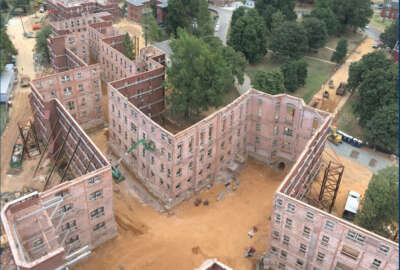 Exclusive
Exclusive  Exclusive
Exclusive As Department of Homeland Security Secretary Kirstjen Nielsen packs her bags for a much-anticipated move to a new headquarters across the Anacostia River next...
Best listening experience is on Chrome, Firefox or Safari. Subscribe to Federal Drive’s daily audio interviews on Apple Podcasts or PodcastOne.
As Department of Homeland Security Secretary Kirstjen Nielsen packs her bags for a much-anticipated move to a new headquarters across the Anacostia River next month, the General Services Administration has proposed demolishing five historic buildings on the St. Elizabeths campus in order to keep plans for a consolidated DHS headquarters on track.
Nielsen, during a speech Monday at George Washington University, said the agency’s scattered office footprint across the Washington metro area represented “a relic of our early days.”
By contrast, the St. E’s campus, she added, stands out as one of the largest government construction projects since the Pentagon, and would allow the agency to better coordinate with its component offices.
“In less than a month, it will serve as the base of operations for a more focused, a more unified, and a more effective and consolidated Department of Homeland Security,” Nielsen said.
A DHS spokeswoman, in an email to Federal News Network on Monday, clarified that beginning April 1, the agency’s Office of the Secretary and executive management will begin to relocate to the St. Elizabeths campus, joining staff from the Office of Operations Coordination that moved to the campus earlier this month.
All told, this phase of the relocation will bring an additional 1,000 employees to the St. E’s campus, not including the 3,700 Coast Guard headquarters staff also located on the site.
GSA and DHS, in fiscal 2020 budget documents released Monday, have together requested more than $400 million to continue work on the St. E’s campus.
By bringing DHS under one roof in the Washington metro area, GSA expects its partner agency will save money on commercial leases and allow DHS employees to collaborate more easily.
However, at a National Capital Planning Commission meeting earlier this month, Kristi Tunstall Williams, director of GSA’s historic preservation and arts division, said the challenge going forward is convincing lawmakers whether the campus consolidation can still go forward as originally planned.
“To date, while we have invested a tremendous amount in the campus — both in terms of construction, but also infrastructure to support it … we haven’t really achieved a substantial consolidation of DHS on the site,” Williams said at the March 7 meeting. “We need to show to our appropriators that yes, we can achieve this, and we can get a critical number of the agencies on the campus.”
The Center Building, the future site of the secretary’s office, offers about 260,000 square feet of space, and stands out as one of the largest historic buildings on the campus.
However, the rest of the historic buildings range anywhere between 5,000-to-60,000 square feet, and can accommodate fewer employees than modern facilities.
“The challenge that we’re having is that if we invest what, in some cases, is close to $1,000 a square foot in those buildings, we can’t get very many people in them,” Williams said.
In order to get a “critical mass” of DHS employees out to the St. Elizabeths campus, GSA has proposed demolishing five historic buildings originally planned for adaptive reuse, and constructing new facilities in order to drive the cost down to $350 per square foot.
“They had character, but maybe those were, due to the problems with rehab, I would say more sacrificial,” Otto Condon, an urban design principal with the architect firm ZGF working with GSA on the St. E’s project, told the NCPC.
While GSA has taken steps to “mothball” some of the historic buildings when it took over the campus, Williams said conditions on those facilities have deteriorated through “time and disuse.”
Through forensic analysis of those buildings, GSA also identified deficiencies that originated with the construction of those historic facilities.
Since 2006, GSA has received about 43 percent of the funds it’s requested from Congress and built out more than 2 million square feet on the campus so far.
In the FY 2019 spending bill, lawmakers set aside $120 million for the St. E’s campus, which falls short from the more than $170 million DHS requested to build a new Federal Emergency Management Administration headquarters.
At a House Homeland Security Committee hearing in April 2018, GSA and DHS officials told lawmakers they’d gone back to the drawing board to create a new St. E’s timetable that factors in budget shortfalls and delays in construction, and expected to complete a new master plan for the project before the end of calendar year 2018.
Condon said the agency expects to submit a new draft master plan to the NCPC by fall 2019, and a final master plan by July 2020.
Copyright © 2025 Federal News Network. All rights reserved. This website is not intended for users located within the European Economic Area.
Jory Heckman is a reporter at Federal News Network covering U.S. Postal Service, IRS, big data and technology issues.
Follow @jheckmanWFED
 Exclusive
Exclusive 
